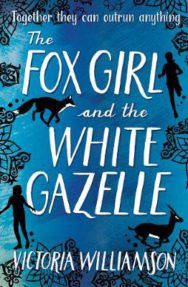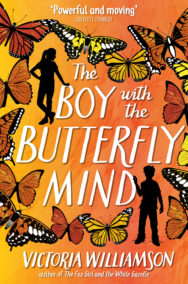‘Maybe I’ll be able to have an operation to fix my brain so I can concentrate and think like normal people.’
Victoria Williamson follows up her critically-acclaimed debut novel The Fox and the White Gazelle with The Boy with the Butterfly Mind. BooksfromScotland caught up with her to hear more about her writing journey.
The Boy with the Butterfly Mind
By Victoria Williamson
Published by Floris Books
Hi Victoria, thanks for speaking with us today. Could you tell us a bit about yourself and your career so far?
I’ve wanted to be a writer ever since I can remember – that’s definitely my parents’ fault for reading me so many stories and taking me to the library every week before I was even old enough to walk! I started writing my first novel – an animal story – in my late teens, which turned into a very long trilogy that I didn’t complete until I was well into my twenties. It wasn’t bad for a first attempt, but it certainly wasn’t publishable.
My teaching work ate up a lot of my writing time for a good few years after that, but as I had plenty of adventures in Africa and China, as well as here in the UK, I’m certainly not complaining. It was very good experience, and I now base a lot of my characters’ voices on the children that I’ve taught over the years.
I’ve been working as an author full time since The Fox Girl and the White Gazelle was released, dividing my time between writing, editing, visiting schools, and running creative writing classes. There’s always lots to keep me busy!
Were there any authors that really inspired you when you were starting out?
I read widely as a child and as a teenager, so my work was influenced by a huge range of writers of different genres. I particularly enjoyed fantasy stories such as The Hobbit and The Lord of the Rings by J.R.R Tolkein, horror stories by James Herbert, science fiction by Ursula K. Le Guin, animal stories by Richards Adams, humorous books by Terry Pratchett and Douglas Adams, and the classics by Jane Austen and Charlotte Bronte. That’s a rather confusing collection of influences, so it took me quite a while to decide what kind of stories I wanted to write. Like many authors, I was drawn back into the world of children’s fiction by J.K Rowling’s Harry Potter series, so if I had to cite one defining inspiration, it would definitely be hers.
Could you walk us through the method you use for writing your books?
I used to spend a lot of my time plotting out everything that was to happen in a book in minute detail, but these days I’m a bit more relaxed about letting the story unfold naturally as I’m writing it. Now I tend to loosely follow the five-point narrative structure of exposition, rising action, climax, falling action and resolution, which helps give shape to a plot, without being too prescriptive. I’ve found that the most important thing is character voice, so as long as I’m clear about who the characters are and what they want before I start, they generally drive the plot forward naturally themselves without every detail needing to be planned in advance.
What’s your favourite thing about being a writer?
Writing books! I know that might seem obvious, but a huge amount of an authors’ time is spent visiting schools, talking at festivals, running writing workshops and promoting their work. Although these are also an enjoyable part of the job, they all require a lot of time-consuming admin to organise, and that’s before editorial work to novels waiting for publication is even added in! All of this other work means that finding uninterrupted time to sit down and actually write can be difficult, so when I do get a block of time to work solely on a new book, I really appreciate it.
Tell us about your new book – The Boy with the Butterfly Mind.
The action centres around two main characters. The first is eleven-year-old Elin, whose parents are divorced, and who is trying to be as perfect as possible as she thinks that will convince her dad to leave his new family and come and live with her and her mum again. The second is Jamie, whose parents are also divorced, and who is just trying to be normal despite his ADHD making things difficult for him.
When Jamie’s mum moves to America with her new partner, Jamie is sent to live with his dad. But Jamie’s dad now lives with Elin’s mum, which ruins Elin’s fairytale ending of getting her own father back. Jamie and Elin’s polar opposite personalities create conflict, and when things spiral out of control, they come to realize the only way they can save their blended family is to admit they’re more alike than they first thought.
It’s a story about divorce, blended families, and ultimately, accepting that happy-ever-afters come in all shapes and sizes.
Can you tell us a bit about your research for The Boy with the Butterfly Mind?
A lot of the inspiration for my stories comes from the real-life experiences of children I have taught in primary schools. Many children are members of blended families, and some of them initially struggle with the changes and transitions that a changing home lifer can bring about. Some of these children share how they’re feeling with their class teacher, so I’ve heard a number of real-life stories from them over the years of jealousies, power struggles, arguments, and ultimately acceptance, although nothing as extreme as Elin and Jamie’s story! I’ve also taught a number of children with additional support needs, including ADHD, so I felt it was really important for them to see a child with ADHD portrayed positively in a story that they could relate to.
Is there any advice you would give to aspiring writers?
Don’t write in a vacuum – that’s a mistake I made, and one of the main reasons why it took me so long after writing my first novels to get published. I was re-inventing the writing wheel myself, and making the same mistakes over and over again. If possible, join a writing community to support you on your journey. I’m very lucky that my younger brother has always acted as my beta reader, but it’s also important to be part of a community that includes professionals who can give you up-to-date industry advice, as well as editorial feedback. There are lots of great organisations that support writers, from writing groups, local SCBWI groups, The Book Trust/The Scottish Book Trust, to literary festivals such as Bath and Winchester, where you can not only meet other writers and attend workshops, but you can get one-to-one feedback on your work-in-progress. Writing can at times be a very solitary pursuit, and being part of a supportive community – whether in person or even online on Twitter or Facebook – can make all the difference when the going gets tough.
Lastly, what’s next?
My next work’s still hush-hush at the moment, but what I can say is that it’s Scottish historical middle grade, featuring a famous real-life person. More to follow – watch this space!
The Boy with the Butterfly Mind by Victoria Williamson is published by Floris Books, priced £9.99
ALSO IN THIS ISSUE

 Kristian Kerr Reviews: To Calais, In Ordinary Time
Kristian Kerr Reviews: To Calais, In Ordinary Time
‘When travelling towards the pestilence was a theoretical possibility, I had fortitude. Now I may ac …

 The Girl Who Lost Her Shadow
The Girl Who Lost Her Shadow
‘Gail fought to make her legs move faster but the shadow was always ahead of her.’














